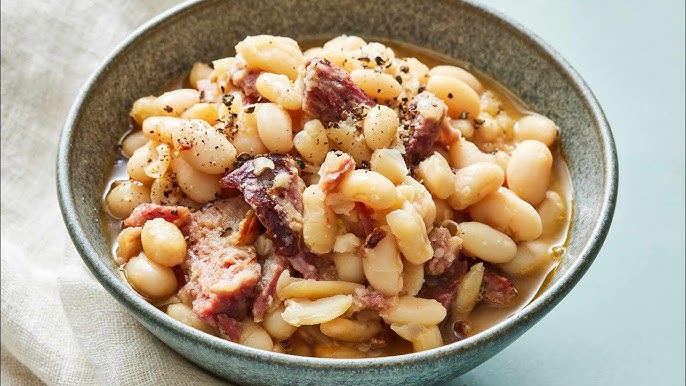Northern Beans Recipe: There’s something comforting about a warm bowl of perfectly cooked Northern beans — creamy, hearty, and deeply satisfying. This dish has been a classic in American kitchens for generations, thanks to its simplicity, nutrition, and versatility. Whether served as a side dish, a main course, or a base for soups and stews, Northern beans deliver both flavor and nourishment.
What Are Northern Beans?
Northern beans, often referred to as Great Northern beans, are medium-sized white beans known for their mild, nutty flavor and smooth texture. They’re part of the common bean family and are similar to navy or cannellini beans but slightly larger. These beans hold their shape well during cooking, making them perfect for long simmered dishes or slow cooker meals.
Why You’ll Love This Recipe
You’ll love this Northern Beans recipe because it’s incredibly flexible — you can make it vegetarian, load it with ham or bacon for smoky depth, or spice it up with herbs and seasonings. Plus, it’s high in protein, fiber, and plant-based nutrients, making it a healthy addition to any meal. It’s the kind of recipe that warms you from the inside out, ideal for chilly evenings or cozy family dinners.
Ingredients You’ll Need
Cooking Northern beans doesn’t require fancy ingredients — just a handful of simple pantry staples and a few fresh aromatics to bring the dish to life.
Main Ingredients
Here’s what you’ll need to make the perfect pot of Northern beans:
- 1 pound dried Great Northern beans – rinsed and sorted
- 6 cups water or low-sodium chicken broth – for simmering
- 1 medium onion, chopped – adds natural sweetness
- 2 cloves garlic, minced – for depth of flavor
- 1 smoked ham hock or 1 cup diced ham – for a rich, smoky taste
- 1 teaspoon salt – added at the end to preserve bean texture
- ½ teaspoon black pepper – to balance flavors
- 1 bay leaf – enhances aroma and adds subtle complexity
Optional Add-Ins for Extra Flavor
To make your dish stand out, consider these optional ingredients:
- 1 teaspoon smoked paprika – adds a bold, smoky note
- 1 carrot and 1 celery stalk, diced – extra sweetness and texture
- ½ teaspoon thyme or rosemary – for an herby touch
- 1 tablespoon olive oil or butter – for richness
Substitutes for Dietary Preferences
If you’re cooking for specific dietary needs, here are a few swaps:
- Vegetarian/Vegan: Replace ham with 1 teaspoon liquid smoke or 1 tablespoon miso paste for umami.
- Low-Sodium: Use unsalted broth and limit added salt.
- Gluten-Free: This recipe is naturally gluten-free — just ensure your broth is certified gluten-free.
Kitchen Tools and Equipment
Cooking a great pot of Northern beans is easy when you have the right tools.
Must-Have Tools
- Large pot or Dutch oven: Ideal for even heat distribution.
- Colander: For rinsing and draining the beans.
- Wooden spoon: To stir gently without breaking the beans.
- Measuring cups and spoons: To ensure proper proportions.
Helpful Additions for Efficiency
- Slow cooker or Instant Pot: For hands-off cooking.
- Ladle: Perfect for serving the beans neatly.
- Storage containers: For refrigerating leftovers or freezing portions.
Step-by-Step Guide to Making Northern Beans
Now comes the best part — cooking! Follow these easy steps for delicious, creamy Northern beans every time.
Step 1 – Soaking the Beans
Soaking is optional but highly recommended for better texture and faster cooking. Place the beans in a large bowl, cover with 3 inches of water, and let them soak overnight (8–12 hours). Drain and rinse before cooking. If short on time, use the quick soak method: bring beans and water to a boil, cook for 2 minutes, turn off the heat, cover, and let them sit for 1 hour. Drain and proceed.
Step 2 – Preparing the Aromatics
While the beans soak, prep your aromatics. Chop onions, mince garlic, and dice any optional vegetables like carrots and celery. In your Dutch oven, heat olive oil over medium heat and sauté the onions and garlic until fragrant and translucent. This step develops the base flavor that infuses the beans later.
Step 3 – Cooking the Beans
Add the soaked beans to the pot with sautéed aromatics. Pour in 6 cups of water or broth, add the ham hock (if using), and bring everything to a gentle boil. Once boiling, reduce the heat to low and simmer uncovered for about 1½ to 2 hours. Stir occasionally and skim off any foam that forms on the surface.
Step 4 – Seasoning and Simmering
When the beans are nearly tender, remove the ham hock to shred the meat (if used). Add salt, pepper, and any herbs at this stage. Continue to simmer uncovered for another 20–30 minutes until the beans are creamy and the broth thickens slightly. Adjust seasoning to taste.
Step 5 – Serving Suggestions
Serve the beans hot, garnished with fresh parsley or a drizzle of olive oil. Pair them with cornbread, rice, or roasted vegetables for a full meal. They also make a fantastic side dish to grilled meats or can be blended into soups for extra creaminess.
Tips for Perfectly Cooked Northern Beans
Cooking beans might sound simple, but a few small techniques can make a huge difference in the texture and flavor. These tips will help you create creamy, flavorful Northern beans that never turn mushy or bland.
Avoiding Overcooking
One of the biggest mistakes people make is overcooking their beans. Overcooked Northern beans can become mushy, losing their lovely shape and bite. To prevent this:
- Monitor cooking time carefully. Start checking the beans after 60 minutes of simmering. The exact time can vary depending on the age of the beans and how long they soaked.
- Avoid boiling too hard. A gentle simmer is key. A rolling boil can cause the skins to burst.
- Add salt at the right time. Adding salt too early can toughen the beans. Always season when they’re nearly tender — during the last 30 minutes of cooking.
- Test for doneness. The beans should be tender but not falling apart. Press one between your fingers — it should mash easily without feeling grainy inside.
Enhancing Flavor Naturally
Northern beans have a mild, buttery flavor that beautifully absorbs whatever you cook them with. To maximize their taste:
- Sauté aromatics first. Never skip this step! Onions, garlic, and celery sautéed in olive oil or butter create a flavor base that transforms the dish.
- Add acidity at the end. A splash of lemon juice or apple cider vinegar at the end brightens the flavor and balances richness.
- Layer your seasonings. Add herbs like thyme, bay leaf, or rosemary early for depth, and finish with fresh parsley or pepper for a fresh pop.
- Use broth instead of water. If you want richer flavor, cook the beans in chicken or vegetable broth rather than plain water.
These tips might seem small, but they make the difference between an ordinary pot of beans and one that’s unforgettable.
Nutritional Information
Northern beans aren’t just delicious — they’re also packed with nutrients that make them a powerhouse ingredient for a healthy lifestyle.
Health Benefits of Northern Beans
- High in protein: One cup of cooked Northern beans provides about 15 grams of plant-based protein — perfect for vegetarians or anyone cutting back on meat.
- Rich in fiber: They contain around 12 grams of fiber per cup, which supports digestion and helps maintain a healthy weight by keeping you fuller for longer.
- Low in fat: These beans are naturally low in fat and cholesterol-free, promoting heart health.
- Excellent source of minerals: Northern beans provide iron, magnesium, potassium, and folate, all of which support energy levels, nerve function, and overall wellness.
- Good for blood sugar: The fiber and protein combination helps stabilize blood sugar, making them a great choice for diabetics or anyone seeking balanced energy.
Calories and Macros Breakdown
Here’s a quick nutritional breakdown per 1-cup serving (without added ingredients):
| Nutrient | Amount | % Daily Value |
|---|---|---|
| Calories | 210 | — |
| Protein | 15 g | 30% |
| Fat | 0.9 g | 1% |
| Carbohydrates | 37 g | 12% |
| Fiber | 12 g | 48% |
| Iron | 3.6 mg | 20% |
| Potassium | 620 mg | 13% |
Adding ham or butter will increase calories slightly, but you’ll also get more flavor and satisfaction. If you’re looking to make your diet healthier, Northern beans are an easy and budget-friendly way to add protein and fiber without excess calories.
Variations of Northern Bean Recipes
One of the best parts about this dish is its versatility. Northern beans are a blank canvas — mild enough to blend with many cuisines and ingredients. Here are a few popular variations you can try:
Smoky Ham and Northern Beans
This Southern classic is perfect for chilly evenings. Simply follow the base recipe but add a smoked ham hock or bacon pieces early in the cooking process. The smoky, salty flavor infuses the beans beautifully. For extra heartiness, add chopped carrots and celery. Serve with cornbread or collard greens for a true comfort meal.
Vegan Northern Bean Stew
Skip the meat and make a flavorful vegan version instead. Start by sautéing onions, garlic, carrots, and celery in olive oil. Add diced tomatoes, vegetable broth, thyme, and smoked paprika. Simmer with the beans until creamy. This stew pairs wonderfully with crusty bread and a sprinkle of fresh herbs.
Southern-Style Creamy Northern Beans
If you prefer a creamy texture, cook the beans slightly longer, then mash a portion with a fork or immersion blender to thicken the broth. Add a touch of butter or cream for richness, and season with black pepper, cayenne, and a dash of vinegar to balance the flavors.
Each variation has its own personality — from rustic and smoky to light and herby — but they all share one thing in common: deliciousness in every bite.
Storing and Reheating Northern Beans
If you make a big batch (which is always a good idea), Northern beans store beautifully for future meals.
Refrigeration Tips
Allow the beans to cool completely before transferring them to airtight containers. They’ll stay fresh in the refrigerator for up to 5 days. When reheating, add a splash of water or broth to loosen the sauce since it thickens as it cools.
Freezing and Thawing Instructions
For long-term storage, freeze the beans in portion-sized containers or freezer bags. Label with the date and freeze for up to 3 months. When ready to eat, thaw overnight in the fridge and reheat gently on the stove. This makes weekday meal prep effortless — just reheat, season, and serve.
Common Mistakes to Avoid
Even the simplest recipes can go wrong if a few key steps are overlooked. Northern beans are forgiving, but certain errors can affect their texture and flavor. Here’s what to watch out for when making this dish.
Using Too Much Salt Early On
This is perhaps the number one mistake when cooking beans. While salt enhances flavor, adding it too soon can prevent the beans from softening properly. The sodium toughens the skins, leading to unevenly cooked or crunchy beans. Always wait until the beans are nearly tender before seasoning.
Instead, you can build flavor early using aromatics and herbs like onions, garlic, bay leaf, or thyme. These ingredients infuse the beans while allowing them to cook perfectly soft and creamy. Once they’re almost done, season with salt and pepper to taste.
Rushing the Cooking Process
Patience is key with beans. Many people turn up the heat to speed things up, but boiling beans too hard can cause them to split or disintegrate. Always cook at a gentle simmer — low and slow is the rule for the best texture.
If you’re in a hurry, try using an Instant Pot or pressure cooker, but still follow the right soaking and seasoning steps. And remember: the longer, slower method on the stovetop develops deeper flavor and creaminess.
Skipping the Soak
Soaking the beans overnight or using a quick-soak method helps reduce cooking time and improves digestibility. Skipping this step can make the beans take hours longer to cook and might result in a gritty texture. Soaking also helps remove some of the compounds that cause bloating — a win-win!
Ignoring the Liquid Ratio
Beans absorb a lot of water during cooking. If you don’t use enough liquid, they may scorch at the bottom or cook unevenly. Always make sure there’s at least 2 inches of liquid above the beans at the start of simmering, and add more if it starts to dry out.
Not Letting the Flavors Marry
Once your beans are cooked, don’t serve them right away. Letting them sit for 15–20 minutes after cooking allows the flavors to meld beautifully. The broth thickens, and the seasoning becomes more balanced. It’s worth the wait!
FAQs about Northern Beans Recipe
Q1. Can I add tomatoes to my Northern beans?
Yes, but only after the beans are fully cooked. The acidity in tomatoes can prevent beans from softening if added too early. Stir in diced tomatoes or tomato paste near the end of cooking for a tangy twist.
Q2. How can I make my beans creamier?
Mash a small portion of the beans against the side of the pot or use an immersion blender for a few seconds. This thickens the broth naturally and gives the beans a luscious texture.
Q3. How do I reduce gas from beans?
Soak the beans overnight, rinse them thoroughly, and cook them with a piece of kombu (a type of seaweed) or a pinch of baking soda. These methods help break down indigestible sugars that cause gas.
Q4. Can I make this recipe spicy?
Of course! Add diced jalapeños, red pepper flakes, or a few drops of hot sauce while cooking for a kick of heat. Adjust to your preference.
Q5. How long can cooked Northern beans stay in the fridge?
They’ll stay fresh for up to 5 days in an airtight container. Reheat gently on the stove or in the microwave with a splash of water to restore their creamy texture.
Conclusion
Northern beans are the epitome of comfort food — simple, wholesome, and endlessly adaptable. Whether you’re making a hearty pot with smoky ham or keeping it vegan with aromatic herbs and broth, this dish delivers warmth and nourishment in every spoonful.
Cooking Northern beans from scratch may take time, but it’s time well spent. The slow simmer allows the beans to soak up all the rich flavors of onions, garlic, and spices, resulting in a meal that feels both rustic and satisfying. Plus, with their high protein and fiber content, they’re as nutritious as they are delicious.
So next time you’re craving something cozy, skip the canned stuff and make your own Northern beans from scratch. Your kitchen will smell amazing, your taste buds will thank you, and your family will ask for seconds.



